Tour Sensoji Temple in Asakusa, Tokyo (with video)
Here is what you will see in this article about touring SensoJi Temple in Tokyo
- A 360 video walkthrough from front gate to temple
- A written guide of top things to see there
- Tours you can book when you visit
I went there in May with my 360 camera and took videos and pictures there and all around Tokyo and Japan.
Turn on captions in video for a text guide or just enjoy looking around in 360. See full tour guide of video down below in article.
SensoJi Temple map with key in Tokyo
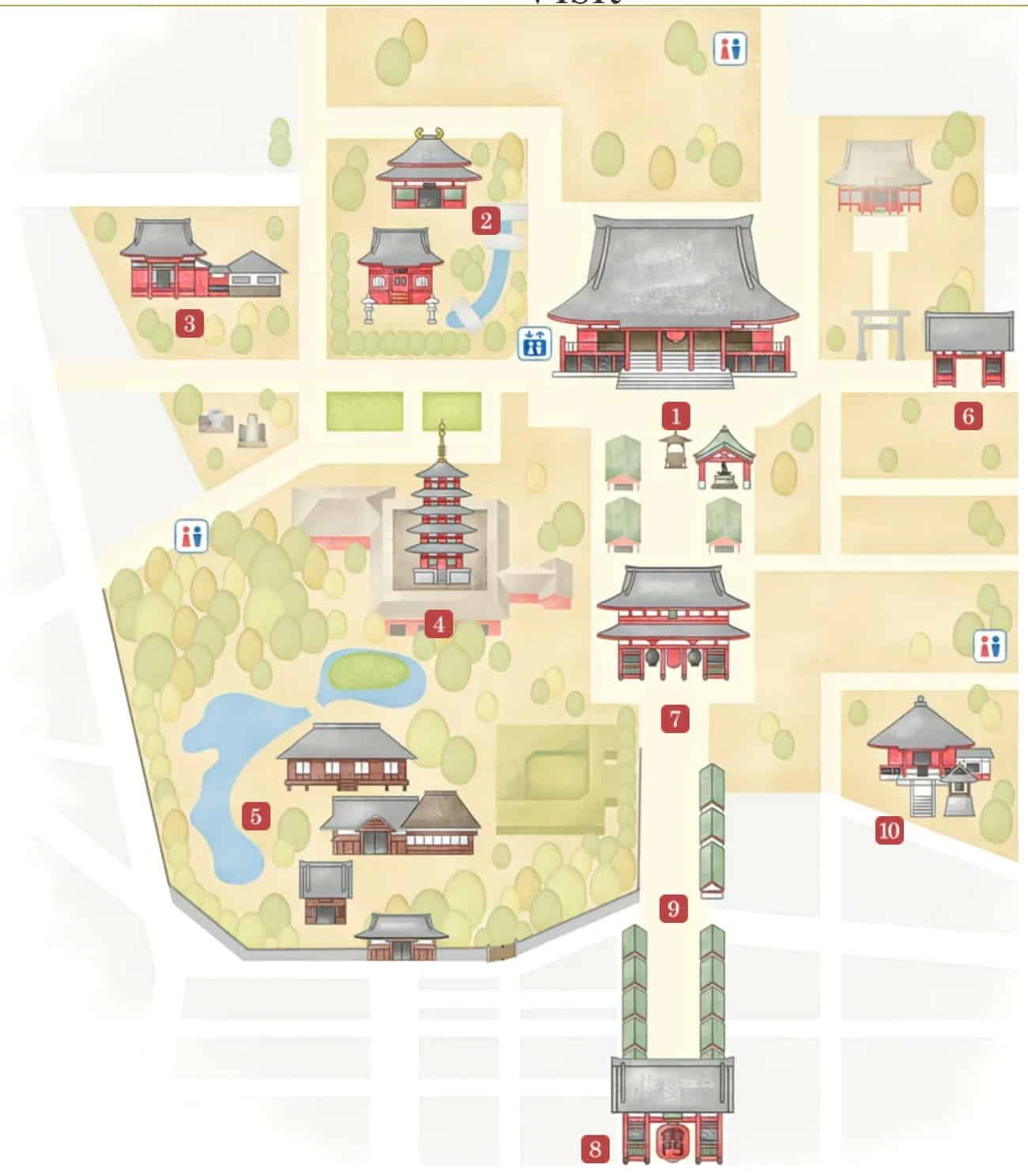
Key
1 Main Temple
4 Five Storied Pagoda
7 Hozomon Gate
8 Kaminarimon Gate
Best Tour to book in Tokyo
The best tour is the private one where you can decide exactly what is important to you.
This tour has over 600 reviews 5⭐
6 hour walking tour but guide can take you around city on public transportation
Enjoy the sights without getting lost or spend time on lots of planning
Table Of Contents:
- History
- Virtual Tour of Senso-Ji Temple
- Visit the Gates
- Nakamise Shopping Street
- Traditional Japanese Cuisine
- Festivals at Senso-Ji Temple
- Tours in Asakusa, Tokyo
- FAQs
Explore the History of Senso-Ji Temple
If you’re a history buff or simply curious about Japanese culture, don’t miss the ancient Senso-Ji Temple in Asakusa, Tokyo. This Buddhist temple dates back to 628 AD and boasts a rich cultural heritage.
Legend has it that two brothers fished out a statue of Kannon (the goddess of mercy) from Sumida River while fishing. Even after they put it back into the river, it kept returning to them. Consequently, Senso-ji was built nearby for the goddess of Kannon.
The temple complex includes several buildings such as the main hall (Hondo), a five-storied pagoda, and various other auxiliary buildings that are perfect examples of traditional Japanese architecture.
Ancient Yet Resilient
In its long history spanning almost 1400 years, Senso-Ji has survived many disasters including fires and earthquakes, but most notably World War II bombings that left much of it destroyed.
However, like a phoenix rising from the ashes, each time it was rebuilt preserving its original style, making it a symbol of rebirth and peace for Japanese people.
Beyond being the oldest temple in Tokyo, Senso-ji also holds immense cultural significance for locals who visit here regularly for prayer or meditation.
It’s considered a very auspicious place, especially during New Year celebrations when millions flock here seeking blessings for the year ahead.
Key Thought:
The Senso-Ji Temple in Asakusa, Tokyo is an ancient Buddhist temple with a rich cultural heritage dating back to 628 AD. It has survived many disasters including World War II bombings and holds immense cultural significance for locals who visit here regularly for prayer or meditation.
Take a Virtual Tour of SensoJi Temple
See before you go!
You can experience Senso-Ji Temple from the comfort of your own home with my immersive 360 VR video tour above.
The virtual tour begins at the Kaminarimon Gate, where you’ll be greeted by its imposing red lantern. From there, follow the bustling Nakamise Shopping Street lined with traditional Japanese shops selling everything from snacks to souvenirs.
You will then enter through Hozomon Gate into Senso-ji’s main grounds. Here, you’ll see worshippers purifying themselves before offering prayers in front of the Main Hall (Hondo). The five-storied pagoda stands tall next to Hondo – an architectural marvel that adds to temple’s grandeur.
This isn’t just any regular video; it’s interactive. Feel free to pause anytime or zoom in on areas that pique your interest most. This way, not only do you get a comprehensive overview but also have control over what aspects intrigue you more during your virtual visit.
You can always see me holding the selfie stick to the camera if you look down.
Tips For Best Viewing Experience:
- Adjust settings to select highest resolution
- To navigate around scenes use mouse or touch screen gestures.
- If using phone, its best to watch on YouTube app
Key Thought :
The article provides a virtual 360 VR video tour of Senso-Ji Temple in Asakusa, Tokyo. Viewers can explore the temple’s main grounds and iconic structures. The interactive experience allows viewers to pause and look around at areas that interest them most.
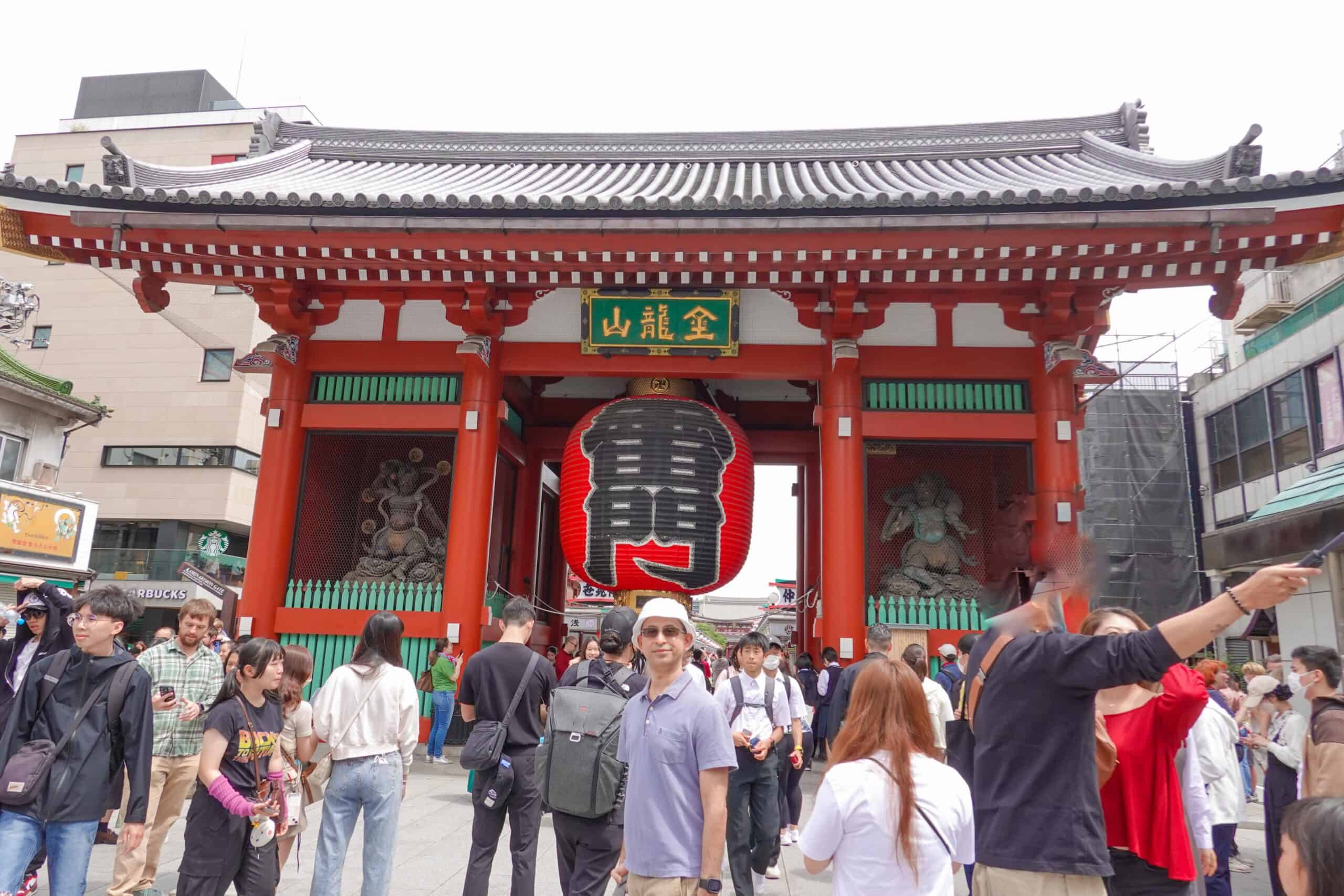
Visit Kaminarimon Gate
Don’t miss the Kaminarimon Gate – the grand main entrance to the temple and an integral part of its rich history.
The Kaminarimon, or “Thunder Gate“, features a massive paper lantern painted in vivid red-and-black tones to suggest thunderclouds and lightning.
Beyond its stunning visual appeal, this gate has significant cultural value as it symbolizes protection from evil spirits and good fortune for visitors.
As you approach this main gate, take some time to appreciate its intricate design elements. The gate houses four statues that represent different deities believed to protect humanity. On your left side stands Fujin, god of wind while on your right side resides Raijin, god of thunder and lightning.
The enormous lantern hanging under the center of Kaminarimon makes for a fantastic photo backdrop both during the day and at night due to its illumination after sunset.
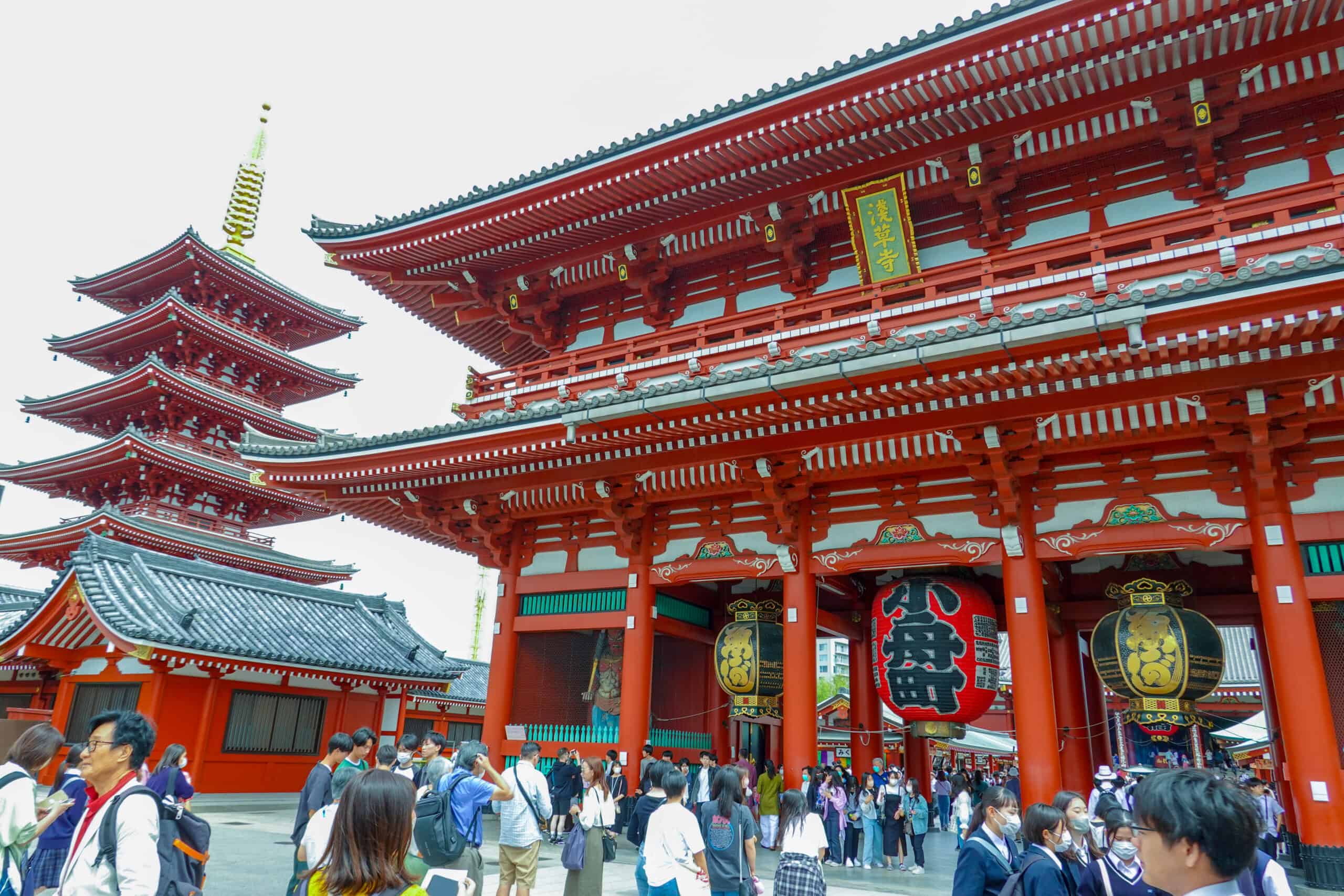
Hozomon Gate: A Gateway To The Past
No exploration at Senso-ji would be complete without visiting Hozomon gate, which houses some important Buddhist relics.
This two-story gate serves as an entranceway leading up towards the main hall, giving visitors a glimpse into the past with its intricate carvings depicting scenes from the life of Buddha on either side of the gateway doors.
Two deities guard either side of the gate, which you can see in my video as I pass under. And after the gates are 2 giant sandals hanging on the walls if you look behind you in the 360 video.
Before entering the main hall ( Hondo ), make sure to wash your hands in the purification fountain on the right. Its decorated with dragons! Check out the picture below.
Also head to the incense pot and offer some coins before going inside. ( all seen near end of video )
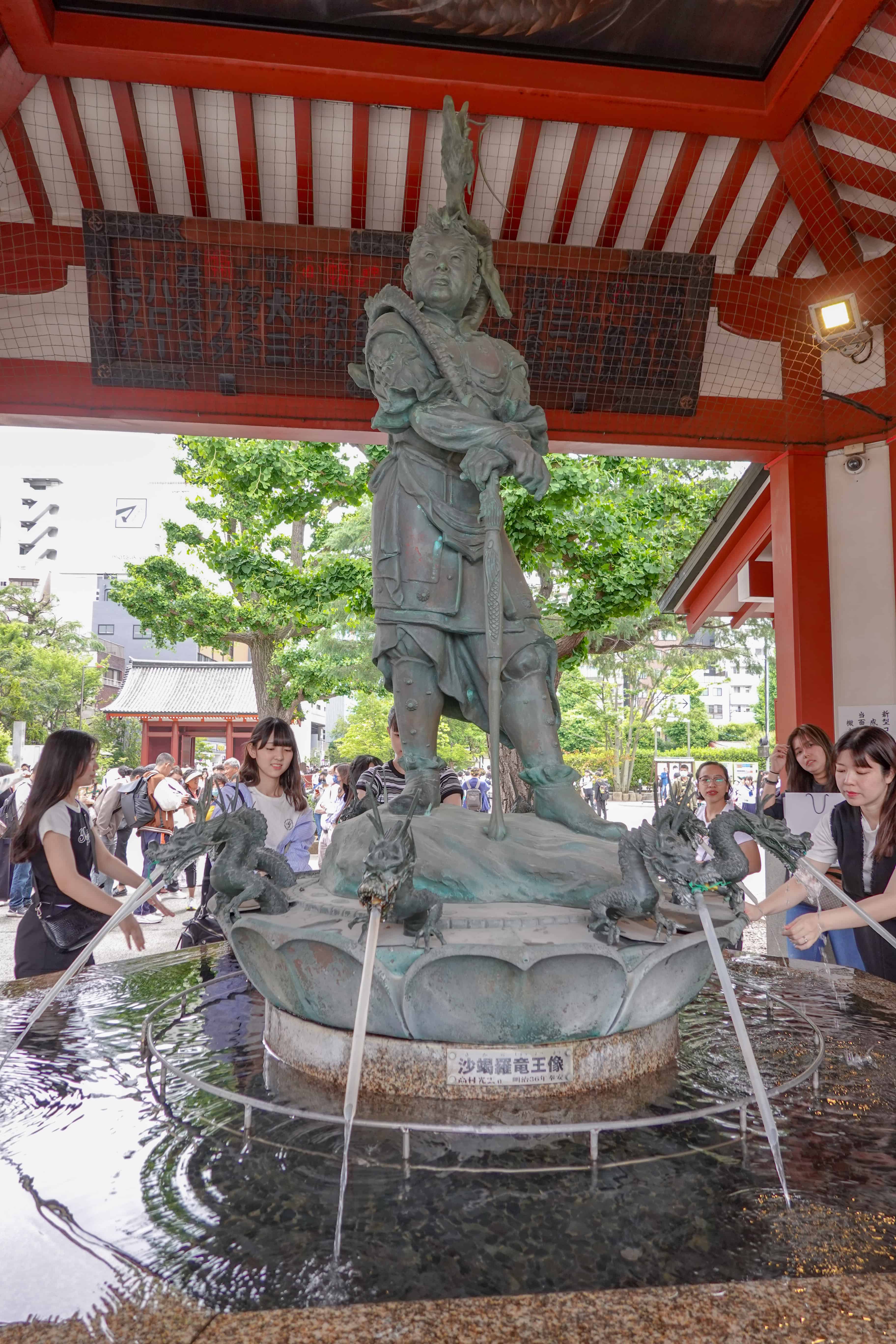
Key Thought:
The Kaminarimon Gate is a must-see attraction when visiting Senso-Ji Temple in Asakusa. Its grand entrance features a massive red-and-black paper lantern that symbolizes protection from evil spirits and good fortune for visitors.
The Five-Story Pagoda at Sensoji Temple
As you explore the temple complex of Sensoji Temple, Tokyo’s oldest temple, one structure that stands out is the majestic five-story pagoda. This towering edifice, nestled in the heart of the Asakusa area, is an integral part of your tour when visiting Sensoji Temple.
A Brief History and Architecture
The original five-storied pagoda was constructed in 942 but has been rebuilt several times due to fire damage. The current version we see today dates back to 1973. Each level symbolizes an element – earth, water, fire, wind, and sky or void – reflecting Buddhist cosmology.
Tips for Visitors
- You can’t climb up inside; however, its beauty can be appreciated fully from outside.
- If possible, try visiting during sunset hours; when lit up, it looks exceptionally beautiful.
- Do not miss capturing shots with both the Five-story Pagoda and Tokyo Skytree together, offering a unique contrast between traditional Japan and the modern cityscape.
Shop for Souvenirs at Nakamise Shopping Street
If you want to take a piece of Japan home with you, head to the bustling Nakamise Street outside Senso-Ji Temple in Asakusa. This vibrant market is one of Tokyo’s oldest and most traditional.
In my video above, its the long street of shops between the 2 main gates.
Nakamise offers unique souvenirs that will delight any traveler. From Japanese fans and kimonos to woodblock prints and tea sets, there’s something for everyone here.
- Japanese Fans: Known as “sensu” in Japanese, these hand-held fans come in various designs ranging from traditional floral patterns to contemporary pop culture themes.
- Kimonos: These traditional garments are available in a wide range of colors and styles. You can even find yukatas (summer kimonos) which are lighter and easier to wear.
- Woodblock Prints: Ukiyo-e or woodblock prints make great wall decorations. They depict scenes from history, landscapes or famous actors from Kabuki theatre.
- Japanese Tea Sets: A must-buy if you love green tea. The sets usually include a teapot with matching cups – perfect for hosting your own Japanese tea ceremony back home.
Aside from shopping, Nakamise also offers plenty of food stalls where you can try local snacks like ningyoyaki (small cakes filled with sweet red bean paste), agemanju (deep-fried buns filled with different types of fillings), senbei rice crackers and more.
The street gets particularly lively during festivals when it transforms into a bustling hub full of energy and excitement. So don’t forget to check out the festival schedule before planning your visit.
As you walking down the street in my video, you can look to the right and get a peek at Tokyo Skytree in the distance.
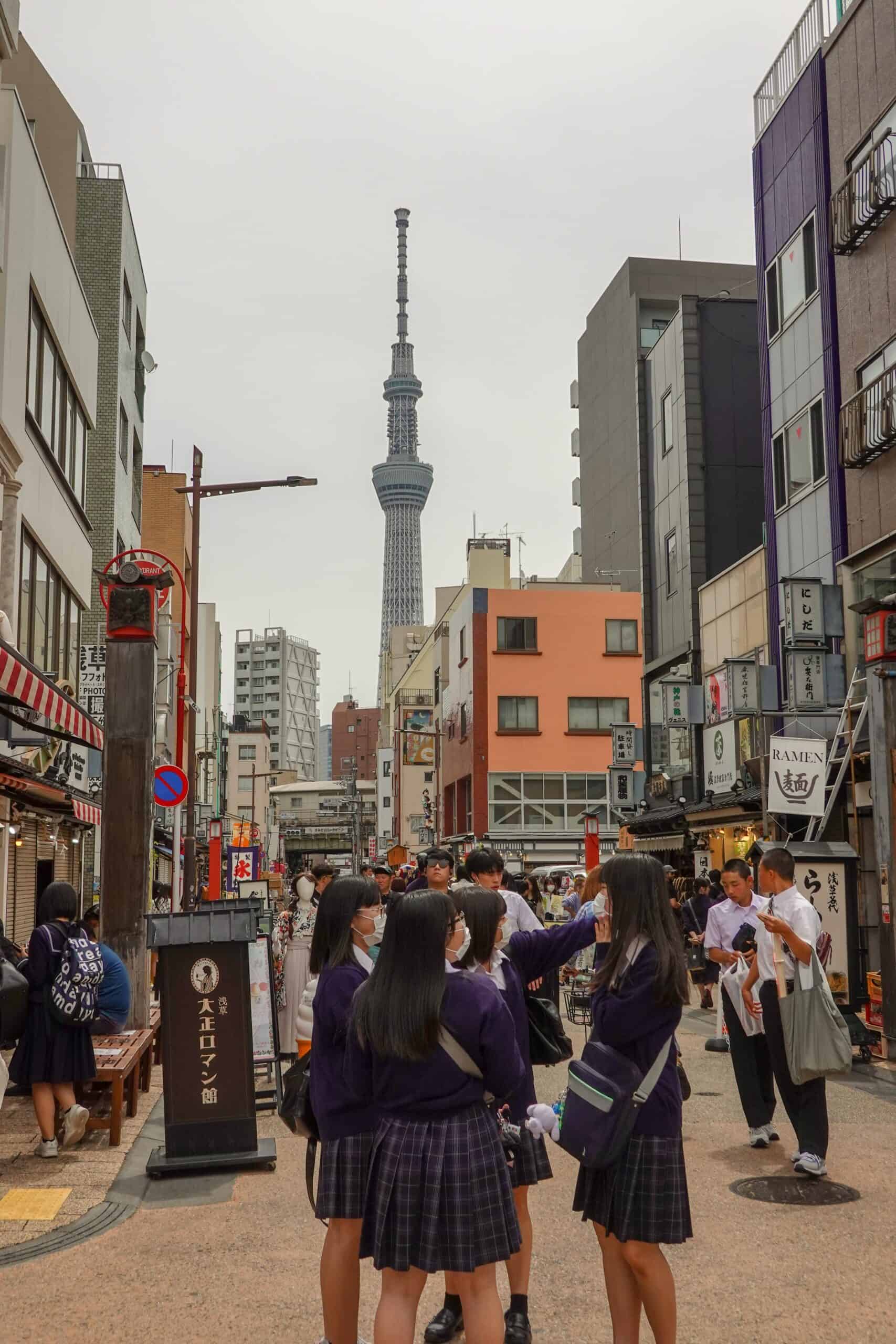
In addition to its shops and eateries, Nakamise is steeped in history too. Many stores have been passed down through generations – some dating back over 100 years. This gives visitors an authentic glimpse into Tokyo’s past while they shop for their souvenirs.
Key Thought: The Nakamise Shopping Street outside Senso-Ji Temple in Asakusa is a vibrant market that offers unique souvenirs for travelers. Visitors can shop for Japanese fans, kimonos, woodblock prints, and tea sets while trying local snacks like ningyoyaki and agemanju from food stalls. The street has a rich history with many stores being passed down through generations giving visitors an authentic glimpse into Tokyo’s past.
Enjoy Traditional Japanese Cuisine around Senso-Ji Temple
Savor Authentic Japanese Flavors
The streets surrounding Senso-Ji are filled with restaurants serving everything from sushi and ramen to tempura and yakitori.
You can find establishments offering both casual street food as well as high-end kaiseki meals, allowing you to experience the full spectrum of Japan’s culinary culture.
Taste Local Specialties
While in Asakusa, don’t miss out on tasting local specialties such as Monjayaki (Tokyo-style savory pancake) or Chanko Nabe (sumo wrestler’s stew). These dishes offer a unique flavor profile that represents Tokyo’s vibrant food scene.
Dine at Traditional Restaurants
A number of traditional restaurants near Senso-ji have been operating for generations, providing visitors with an authentic dining experience steeped in history. For instance, Asakusa Imahan, renowned for its Sukiyaki hot pot dish, has been serving customers since 1895.
Tips for Dining Near Senso-Ji Temple:
- Pick your meal time wisely: Popular eateries can get crowded during lunch and dinner hours, so plan accordingly.
- Try seasonal delicacies: Many places offer menu items based on what ingredients are in season – be sure to ask about these special dishes.
- Venture off main streets: Some of the best finds (and cheaper) are tucked away down side alleys where locals dine.
Experience the Vibrant Festivals at Senso-Ji Temple
Immerse yourself in Japanese culture by participating in the lively festivals held throughout the year at Senso-Ji Temple.
Festivals Galore
The temple hosts numerous annual festivals, each with its unique charm and significance. The most famous is Sanja Matsuri, held every May, where three portable shrines are paraded around Asakusa amidst much fanfare.
Hagoita-Ichi Fair is another notable event celebrated in December. It’s a lively market selling decorative battledores used for a traditional New Year game called Hanetsuki.
Cultural Immersion
Participating in these festivals allows you to witness Japan’s rich cultural traditions up close. You can see locals dressed up in traditional attire performing age-old rituals and dances, taste authentic festival food from street vendors, or even join the processions if allowed.
Tours around Sensoji in Asakusa, Tokyo
Asakusa, a district in Taito, Tokyo, is known for its lively atmosphere and traditional Japanese charm. Visiting Asakusa is an absolute must when you’re in Tokyo, not just for the renowned Senso-Ji Temple but also to take in the many other attractions this area has to offer.
Rickshaw Rides around Asakusa
Tokyo Asakusa Rickshaw Tour
Over 1200 5 ⭐ Reviews
Starting at 30 minutes
Journey Through Tea Ceremony
5⭐
Chado, an ancient zen tea ceremony
1.5 hours with tea and confections
Savor Local Delicacies
Food lovers tour to 4 vendors
5 ⭐
2.5 hours including lunch and alcohol
FAQs in Relation to Tour Senso-Ji Temple in Asakusa
What makes Sensoji Temple a must-visit in Tokyo?
Sensoji Temple, Tokyo’s oldest Buddhist temple, boasts a stunning five-story pagoda, iconic Kaminarimon Gate, and a lively Nakamise Shopping Street.
What is the significance of Asakusa Shrine?
Asakusa Shrine, located within the same grounds as Sensoji Temple, is famous for hosting Tokyo’s largest annual festival – Sanja Matsuri.
What are some other tourist attractions near Sensoji Temple?
Other popular attractions near Sensoji Temple include the Tokyo Skytree, Ueno Park, and the Edo-Tokyo Museum.
How to get to Sensoji Temple?
Only a five minute walk from Asakusa Station in Tokyo.
My other posts around Japan and Tokyo
I travelled all around Tokyo and Japan so I will add my favorite locations here.
Check out these videos of Golden Gai in Tokyo, and narrated tour of Shirakawa-go in Japan.
In the meantime, check out my other blogs and videos from around the world.

